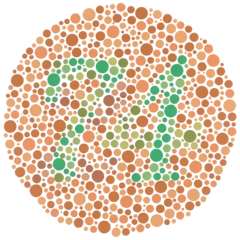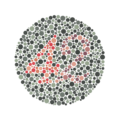Ishihara color test
From Wikipedia, the free encyclopedia

The Ishihara Color Test is a test for red-green color deficiencies. It was named after its designer, Dr. Shinobu Ishihara, a professor at the University of Tokyo, who first published his tests in 1917. [1]
The test consists of a number of colored plates, called Ishihara plates, each of which contain a circle of dots appearing randomized in color and size. Within the pattern are dots which form a number visible to those with normal color vision and invisible, or difficult to see, for those with a red-green color vision defect. The full test consists of 38 plates, but the existence of a deficiency is usually clear after a few plates. Testing the first 24 plates gives a more accurate diagnosis of the severity of the color vision defect.
Common plates include a circle of dots in shades of green and light blues with a figure differentiated in shades of brown, or a circle of dots in shades of red, orange and yellow with a figure in shades of green; the first testing for protanopia and the second for deuteranopia.
Contents |
[edit] Gallery
[edit] See also
[edit] References
- ^ S. Ishihara, Tests for colour-blindness (Handaya, Tokyo, Hongo Harukicho, 1917).
[edit] External links
- Ishihara color test information
- Test of color blindness with the indication of the weaknesses in various colours, quantifies green red blue deficiency ( ISHIHARA test alternative)






